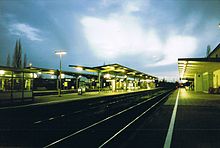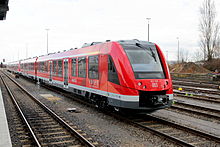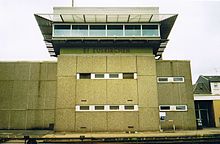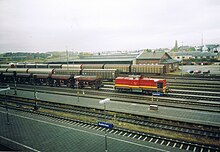Euskirchen station
| Euskirchen station | |
|---|---|
 Euskirchen station with central bus station (spring 2006)
|
|
| Data | |
| Location in the network | Separation station |
| Platform tracks | 5 |
| abbreviation | KEU |
| IBNR | 8000100 |
| Price range | 3 |
| opening | 1864 |
| location | |
| City / municipality | Euskirchen |
| country | North Rhine-Westphalia |
| Country | Germany |
| Coordinates | 50 ° 39 '28 " N , 6 ° 47' 28" E |
| Railway lines | |
|
|
| Railway stations in North Rhine-Westphalia | |
The station Euskirchen is a hub in the regional transport with high commuter traffic . The station is located in the city center of Euskirchen on Alleestraße on the Pützberg. The station , designed as a through station, now has five platform tracks, on which the trains of the Eifel line (Cologne – Euskirchen – Trier) , Voreifelbahn , Erfttalbahn and the Bördebahn run. The station is assigned to station category 3.
history
Early years
In 1846, far outside the city center at that time , Euskirchen's first train station was built in a late classicist style on the Pützberg. The station forecourt was the city's calling card. All pageants through the city began here. The forecourt was planned as a park and placed centrally on a war memorial erected on May 24, 1903, which tapered to a green area. This created lawns , hedges and trees in front of the reception building . As the traffic density increased dramatically, the forecourt was often redesigned. The railway system grew steadily and included a water tower , goods and locomotive sheds , a turntable and five signal boxes .
In May 1928 the war memorial was moved to Hindenburgplatz. In the 1930s, the trees and lawns gradually disappeared. At the end of 1944, the entire depot, including the station building, was destroyed in bombing by the Allies .
Opening of the routes:
- October 2, 1864 - Euskirchen - Düren route
- 1871 - Euskirchen - Trier line
- October 1, 1875 - Euskirchen - Cologne route
- June 7, 1880 - Euskirchen - Bonn route
- October 1, 1890 - Euskirchen - Bad Münstereifel route
Reconstruction and post-war
On August 1, 1945, temporary traffic on the Aachen - Düren - Euskirchen - Bonn route could be started. In 1956 a new station building was built in the same place. The Deutsche Bundesbahn implemented it in a functional architectural style, as was common in the post-war period . The Euskirchen painter and graphic artist Konrad Schaefer designed the window facade. The forecourt was also redesigned. The remaining trees fell and the character of a park was given up. Instead of the planting, an asphalted area was created from 1956 on with holding islands for buses . In the course of the establishment of a central bus station , commuter traffic increased again.
From 1970
The Euskirchen station became an important railway junction again, as it is located on today's course book routes 474 and 475 in the Deutsche Bahn AG network .
As a result of the high volume of traffic, the station received a new central signal box for the equivalent of around 2.9 million euros. After three years of planning and construction, it went into operation on December 12, 1973. A large central bus station has been located on the station forecourt since the 1990s . It has two fully covered platforms, which are served from both sides, and several uncovered bus platforms, which are intended for school buses . There is also an information point for travelers, electronic display boards and an integrated taxi parking lot . To date, the station has 40 tracks , three platforms , the reception building, a central signal box, a goods shed , a waste signal box as well as a double-sided loading lane and several operating buildings. The station area extends over an area of 109,241 m² and the connections branch off in all directions. In the reception building there are lockers , ticket machines, the travel center of Deutsche Bahn AG, a bookstore, a bakery and a branch of the McDonald’s fast food chain . The latter settled in the building around 2002-2004.
Since 2008
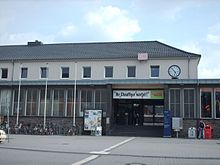
After the signal box was erected in 1973, little structural changes were made to the Euskirchen station, with the exception of the forecourt. The station building and the platforms with their underpasses and roofs were considered obsolete in the new millennium. That is why it was announced in spring 2008 that the station would be part of the "modernization offensive for train stations in North Rhine-Westphalia" by Deutsche Bahn AG. It has been modernized and made barrier-free . Preparations for the major construction site began in July 2008. Around 100 vehicle parking spaces were lost on the park-and-rail area to the south . Parts of the western reception building were demolished and a temporary bridge was built at the eastern end of the platforms. The old underpass, the stairs to the platforms and the roofing were partially or completely demolished and a new 70 m long and 6 m wide pedestrian underpass with three elevators and new staircases were created. The platforms were cm to 76 raised . The lighting, loudspeakers and the wayfinding system were completely renewed. The € 8.3 million construction project was completed in mid-November 2010.
After the platform work, the first changes were made to the relay interlocking built in 1973 , regardless of the “modernization offensive” . The reason was the planned increase in traffic on the Bonn – Rheinbach line during rush hour. For this purpose u. a. the signal box modernized and a new electronic signal box u. a. set up for the Voreifelbahn. In addition, a new train control system was set up for the Voreifelbahn . The measures were announced by DB in 2005, but postponed until the end of 2010 due to lack of funds. By 2013, the entire construction project on the Bonn – Euskirchen – Bad Münstereifel line had been implemented.
expansion
As part of the planned reactivation of the Bördebahn, Euskirchen station is to receive an additional platform on track 46. The platform is to be built by DB Station & Service by June 2020 and then leased by the Rurtalbahn. As a result of this measure, the Bördebahn no longer has to cross the two tracks on the line to Trier during normal operation and can be completely decoupled from the rest of the operations at Euskirchen station.
Tracks
The Euskirchen train station currently has 5 platform tracks:
- Track 1 for scheduled trains from Cologne in the direction of Kall, Gerolstein or Trier ( Eifelbahn )
- Track 2 for trains stopping as scheduled from Trier, Gerolstein or Kall in the direction of Cologne ( Eifelbahn )
- Track 3 for trains stopping as scheduled from Bad Münstereifel or from Bonn back in the direction of Bonn ( Voreifelbahn ) or amplifiers ending in the HVZ from Cologne ( Eifelbahn )
- Track 4 for trains stopping according to schedule in the HVZ to Bonn (if track 3 is occupied by trains from Cologne) and the Bördeexpress to and from Düren
- Track 5 for trains stopping as scheduled from Bonn in the direction of Bad Münstereifel ( Erfttalbahn )
Track 47, a stump track, lost its platform when the station was modernized in 2008. It was the station track of the Bördebahn until passenger traffic was stopped.
traffic
Local rail passenger transport on the Eifel route and Voreifelbahn is carried out by DB Regio NRW . LINT 54 and LINT 81 railcars are used here.
passenger traffic
The station is currently served by the following lines for local rail passenger transport:
At the bus station in front of the reception building, there are various transfer options to the SVE city bus routes and the RVK regional bus routes :
| line | Line course | ||
|---|---|---|---|
| City bus routes: | |||
| 860 | Train station - Lindenweg - Marienhospital - train station (ring line) | ||
| Train station - Nordstadt - Rüdesheimer Ring - train station (ring line) | |||
| 869 | Train station - Lommersum | ||
| 870 | Train station - Großbüllesheim - Kuchenheim - Flamersheim - Kirchheim (- Steinbachtalsperre ) - Kirchheim - Stotzheim - train station (ring line) | ||
| 871 | Memelstraße - train station - Südstadt - Marienhospital | ||
| 872 | Nordstadt - train station - Theodor-Körner-Strasse | ||
| 873 | Train station - Stotzheim - Niederkastenholz - Kirchheim (- Steinbachtalsperre) or Niederkastenholz - Flamersheim - Schweinheim | ||
| 874 | Train station - Kuchenheim - Flamersheim - Kirchheim | ||
| 875 | Train station - Kleinbüllesheim - Großbüllesheim - Wüschheim | ||
| 876 | Train station - Kuchenheim - Weidesheim - Dom-Esch - IPAS - train station (ring line) | ||
| 877 | Train station - cheap - Kreuzweingarten | ||
| 878 | Train station - Euenheim - Wisskirchen | ||
| Regional bus routes: | |||
| SB98 | Euskirchen - Zülpich - Düren (express bus) | ||
| 298 | Euskirchen - Kommerner Strasse - Dürscheven - Zülpich - Füssenich - Düren | ||
| 801 | Euskirchen - Cheap - Arloff - Kalkar - Iversheim - Bad Münstereifel | ||
| 802 | Euskirchen - Palmersheim - Rheinbach-Kurtenberg - Forest | ||
| 806 | Euskirchen - Appelsgarten - Kleinbüllesheim - Dom-Esch - Heimerzheim | ||
| 807 | Euskirchen - Zülpich-Mülheim - Lechenich market | ||
| 808 | Euskirchen - Kommerner Strasse - Wißkirchen - Firmenich - Schaven - Mechernich | ||
| 810 | Euskirchen - Kommerner Strasse - Dürscheven - Zülpich-Schwerfen - Mechernich | ||
| 985 | Euskirchen - A.-Kaufmann-Straße - Wüschheim - Derkum - Weilerswist - Brühl Mitte (tram) | ||
Freight transport
Before 1945 the entire railway system consisted of a water tower, a goods and locomotive shed, a turntable and five signal boxes. Today the Euskirchen marshalling yard consists of a goods shed surrounded by tracks on both sides, a building construction ( relay interlocking ), which is manned around the clock by at least one dispatcher (from there the arriving trains are announced by hand), a locomotive shed, a diesel refueling system, a disposal track and a drainage mountain to simplify the assembly of trains.
The freight yard can be described as a potential or former transshipment station, an important branch was the loading of wood from freight wagons onto trucks (the wood mostly comes from the Eifel ). The loading facilities are no longer used, but are still fully preserved. Furthermore, a weekly (Mondays, Wednesdays and Fridays) freight train from the Strempt landfill was routed to a waiting track at the freight yard . The resident group Procter & Gamble owns a siding in the Derkum station area. Wagons were picked up from this connection several times a day and temporarily stored in the Euskirchen freight yard. Today, these transports are handled by direct block trains from Gremberg (operating days Mon-Fri). The local sugar factory Pfeifer & Langen , whose siding is directly behind the drainage mountain, was served weekly by coal and sugar beet wagons.
Up until the closure of the Vogelsang military training area in the Eifel National Park , armored trains were routed to waiting tracks in the Euskirchen freight yard every month, where they had to wait until they could continue to Höddelbusch . The Zülpich paper factory is served weekly on the Bördebahn. However, these transports are handled via Düren. It also happened that car trains drive from a storage area near Vettweiß via the Bördebahn to Euskirchen and are diverted to waiting tracks there, in some cases staying there for days. Up until 2013, the city connection to which large companies such as Miele are based was operated twice a day . Thus an average of up to 220 wagons per day were handled in freight transport.
The freight yard housed two heavy class 294 radio locomotives . In addition, locomotives from private railway companies were often found on the sidings of the depot.
Most of the train units that are assembled in the freight yard were usually transferred to Cologne- Gremberg .
Today (as of 2020) no more freight trains run in Euskirchen. Although all the systems are still there, they are only used by construction trains , empty locomotives or to park passenger trains.
Web links
- Tracks in service facilities (KEU) , DB Netz AG (PDF)
Individual evidence
- ↑ Query of course book route 474 at Deutsche Bahn.
- ↑ a b Query of course book route 475 at Deutsche Bahn.
- ↑ Euskirchen im Wandel 1st edition 2007 p. 4
- ↑ http://www.wisoveg.de/wisoveg/heimatkalender-eu/110-jahre/110-jahre.html
- ↑ http://www.hans-dieter-arntz.de/zerstoerung_eisenbahnnetzes.html
- ↑ Euskirchen im Wandel 1st edition 2007 p. 5
- ↑ Air survey results of the City of Cologne on March 18, 2009
- ↑ http://www.deutschebahn.com/site/bahn/de/unternehmen/presse/presseinformationen/nrw/nrw20080723,variant=pdf.pdf . As of July 23, 2008.
- ↑ General-Anzeiger of April 14, 2010: A stop for the “Green Center”. Retrieved on September 7, 2017
- ↑ General-Anzeiger: Voreifelstrecke: The railway is in no hurry ( Memento from May 2, 2014 in the Internet Archive ). Retrieved on April 2, 2010
- ↑ Expansion of the RB 23 Bonn-Euskirchen railway line (Voreifelbahn). In: www.bonn.de. City of Bonn - Press Office, March 17, 2010, archived from the original on December 22, 2010 ; Retrieved June 26, 2013 .
- ^ " Zweckverband Nahverkehr Rheinland", 18th association meeting, 9 March 2018
- ↑ http://www.gessen.de/str/dneu.html
- ↑ Press release from Deutsche Bahn on March 23, 2011: DB Regio Rheinland wins contract for the Cologne diesel network. Accessed on March 24, 2011
- ↑ http://www.eifelbahn.de/termine/00021.htm
